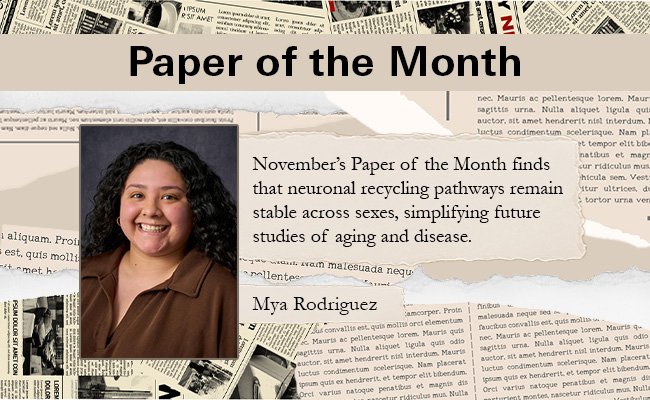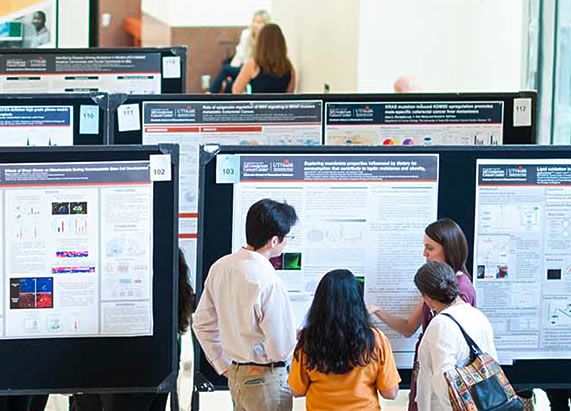November’s Paper of the Month finds that neuronal recycling pathways remain stable across sexes, simplifying future studies of aging and disease.
November 21, 2025 By: Mirrah Bashir/Graduate Student/Molecular & Translational Biology Program/MD Anderson UTHealth Houston Graduate School



Paper of the Month: Sex does not influence neuronal autophagosome biogenesis throughout aging in mice
Aging is often accompanied by a gradual decline in cellular maintenance systems. Neurons, our longest-living cells, are particularly vulnerable to this. One such maintenance system is called autophagy, a cellular process that utilizes structures called autophagosomes to recycle damaged cellular components, thereby helping to maintain cellular health. Neurodegenerative diseases such as Alzheimer's and Parkinson's have shown sex-related differences in their prevalence and progression, and researchers have often asked whether these differences extend to fundamental neuronal functions. Graduate student Mya Rodriguez, a trainee in the Neuroscience program, recently published a study in Molecular Biology of the Cell, showing that despite clinical disparities, biological sex does not influence how neurons form autophagosomes throughout the lifespan of preclinical models. Their findings provide new clarity for neuroscience researchers by showing that both male and female neurons maintain equivalent autophagic capacity as they age, simplifying the design of future studies aimed at understanding and treating age-related neurodegeneration.
Reexamining previous data through a new lens
Previous work from the lab revealed that the formation of the autophagosome, the first step in autophagy, slows dramatically with age in neurons from preclinical models. However, whether this decline differed between males and females remained unknown. To address this, Rodriguez, under the mentorship of Andrea Stavoe, PhD, reanalyzed existing datasets and expanded their experiments to compare autophagy across sexes and life stages directly. Using live-cell imaging and protein profiling techniques, they tracked how neurons from both male and female preclinical models recruited major protein complexes involved in the biogenesis of autophagosomes. This included initiation (ATG13, ULK1) and nucleation (ATG14, Beclin1) to elongation (ATG5, ATG7) and completion (LC3, WIPI proteins). The results were striking in their consistency, with autophagosome formation proceeding identically in both sexes, showing no significant differences at any stage of the pathway or at any age examined.
Rodriguez reflects that her favorite part of writing the manuscript was seeing how each component, almost like pieces of a puzzle, fit together into a unified story.
“It was rewarding to take data from so many different angles and realize they all pointed to the same conclusion. Autophagy is such a complex process and pulling those threads together into something cohesive and clear was incredibly satisfying.”
When taken together, these findings suggest that while sex differences often shape disease outcomes and therapeutic responses, they do not appear to affect the fundamental mechanics of neuronal autophagy. This means that future studies on neuronal recycling and aging can interpret results from either sex with greater confidence, knowing that the core autophagy biogenesis machinery remains consistent across the sexes.
Expanding the reach of the research
This exciting study focused specifically on autophagosome biogenesis, but Rodriguez notes that future work will explore the next steps in the pathway. Particularly, how sex may influence autophagosome maturation and fusion of the lysosomes to degrade cargo.
“Autophagy doesn’t end once the autophagosome forms. There’s still a lot to uncover about how these later stages might contribute to age-related neurodegeneration.”
Along with its immediate findings, this work adds an important piece to the bigger picture of autophagy research. Because many labs, including the Stavoe Lab, also study the hermaphroditic organism, C. elegans, these findings confirm that using such models does not introduce any significant sex bias. As Rodriguez explains, “it reinforces that our data from hermaphrodites is broadly representative, making our findings more translatable to questions of aging and neurodegeneration across species.”
Finding her scientific voice
Reflecting on the writing process, Rodriguez credits Stavoe for shaping her approach to scientific communication.
“She really emphasizes clarity and precision. Working alongside her taught me how to balance depth with accessibility — something I’ll carry with me throughout my PhD.”
Paper of the Month (POM) is a collaborative effort led by Microbiology and Infectious Diseases PhD candidate Jana Gomez and Communications Manager Shelli Manning, and overseen by Associate Dean for Academic Affairs Francesca Cole, PhD, who work with students to summarize fellow student-authored scientific articles about their biomedical science research and the innovative methods and discoveries they are uncovering. The POM editorial team includes students Shraddha Subramanian, Mirrah Bashir (author of November's POM summary), Amanda Warner, Chae Yun Cho, Altai Enkhbayar, Zarmeen Khan, Archit Gupta, and Sheighlah McManus.







